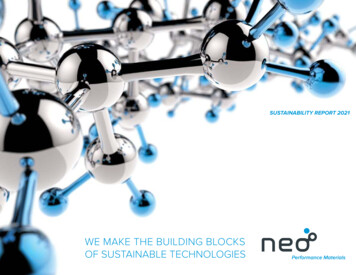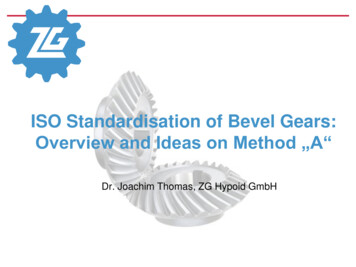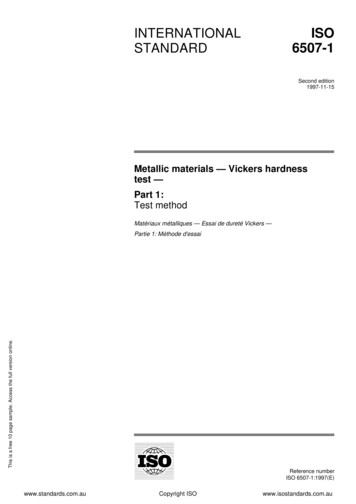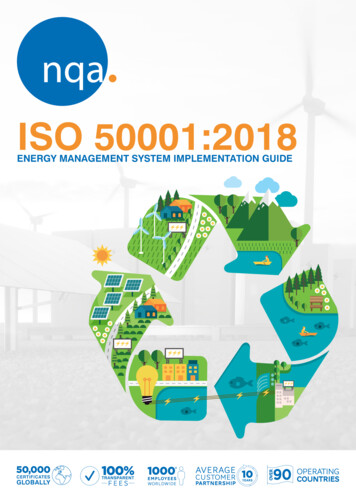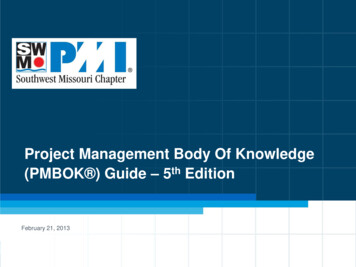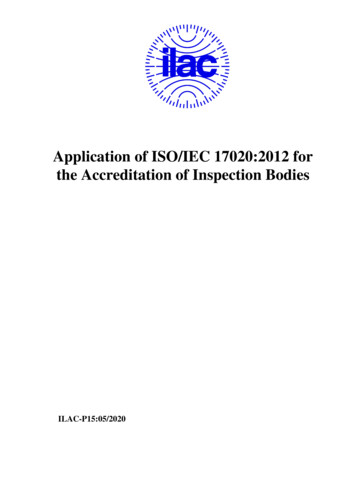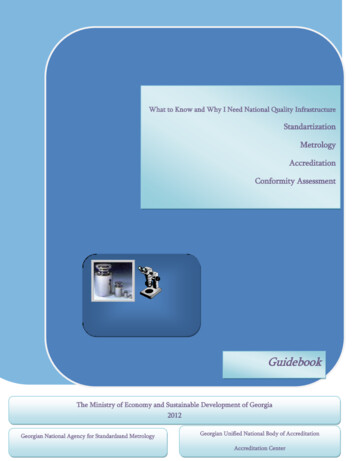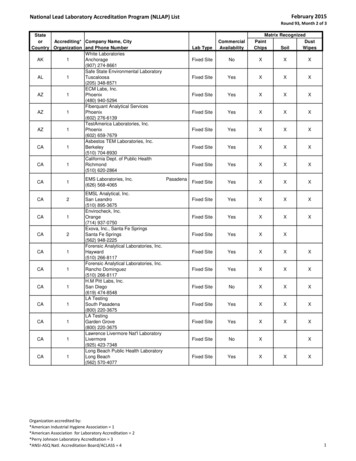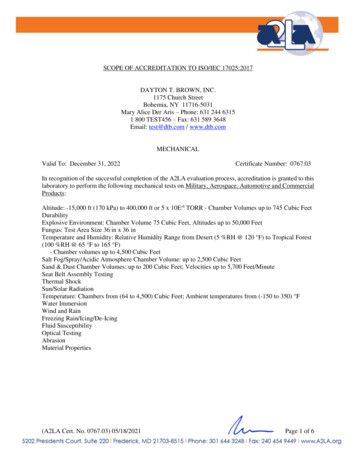
Transcription
SCOPE OF ACCREDITATION TO ISO/IEC 17025:2017DAYTON T. BROWN, INC.1175 Church StreetBohemia, NY 11716-5031Mary Alice Der Aris – Phone: 631 244 63151 800 TEST456 – Fax: 631 589 3648Email: test@dtb.com / www.dtb.comMECHANICALValid To: December 31, 2022Certificate Number: 0767.03In recognition of the successful completion of the A2LA evaluation process, accreditation is granted to thislaboratory to perform the following mechanical tests on Military, Aerospace, Automotive and CommercialProducts:Altitude: -15,000 ft (170 kPa) to 400,000 ft or 5 x 10E-6 TORR - Chamber Volumes up to 745 Cubic FeetDurabilityExplosive Environment: Chamber Volume 75 Cubic Feet, Altitudes up to 50,000 FeetFungus: Test Area Size 36 in x 36 inTemperature and Humidity: Relative Humidity Range from Desert (5 %RH @ 120 F) to Tropical Forest(100 %RH @ 65 F to 165 F)- Chamber volumes up to 4,500 Cubic FeetSalt Fog/Spray/Acidic Atmosphere Chamber Volume: up to 2,500 Cubic FeetSand & Dust Chamber Volumes: up to 200 Cubic Feet; Velocities up to 5,700 Feet/MinuteSeat Belt Assembly TestingThermal ShockSun/Solar RadiationTemperature: Chambers from (64 to 4,500) Cubic Feet; Ambient temperatures from (-150 to 350) FWater ImmersionWind and RainFreezing Rain/Icing/De-IcingFluid SusceptibilityOptical TestingAbrasionMaterial Properties(A2LA Cert. No. 0767.03) 05/18/2021Page 1 of 6
Using the following specifications directly related to the above listed testing parameters and technologies:Test Technology:Test Method(s) 2:Altitude: Low PressureMIL-STD-810C, Method 500.1; MIL-STD-810D, Method 500.2;MIL-STD-810E, Method 500.3; MIL-STD-810F, Method 500.4;MIL-STD-810G, Method 500.5; MIL-STD-810G w/ Change 1,500.6; MIL-STD-810H, 500.6Altitude: TemperatureMIL-STD-810C, Method 504.1; RTCA/DO-160E (4.0)Altitude Temperature / HumidityAltitude ImmersionRTCA/DO-160F; RTCA/DO-160G;MIL-STD-810C, Method 518.1;MIL-STD-1344ALow Temperature /High TemperatureMIL-STD-810C, Method 501.1; MIL-STD-810D, Method 501.2;MIL-STD-810E, Method 501.3; MIL-STD-810F, Method 501.4;MIL-STD-810G, Method 501.5;MIL-STD-810G w/ Change 1, Method 501.6;MIL-STD-810H, Method 501.7;MIL-STD-810C, Method 502.1; MIL-STD-810D, Method 502.2;MIL-STD-810E, Method 502.3; MIL-STD-810F, Method 502.4;MIL-STD-810G, Method 502.5;MIL-STD-810G w/ Change 1, Method 502.6;MIL-STD-810H, Method 502.7;ATPD 2352R, Sections 3.3.1.1, 4.3.1.1, 3.3.1.2, and 4.3.1.2;ATPD 2352T, Sections 3.3.1.1, 4.3.1.1, 3.3.1.2, and 4.3.1.2;RTCA/DO-160E (Section 5); RTCA/DO-160F (Section 5);RTCA/DO-160G;MIL-STD-1344ATemperature ShockMIL-STD-810C, Method 503.1; MIL-STD-810D, Method 503.2;MIL-STD-810E, Method 503.3; MIL-STD-810F, Method 503.4;MIL-STD-810G, Method 503.5;MIL-STD-810G w/ Change 1, Method 503.6;MIL-STD-810H, Method 503.7; MIL-STD-202, Method 107G;ATPD 2352R, Sections 3.3.4 and 4.3.4;ATPD 2352T, Sections 3.3.4 and 4.3.4;RTCA/DO-160E (Section 5); RTCA/DO-160F (Section 5);RTCA/DO-160GSolar Radiation (Sunshine)MIL-STD-810C, Method 505.1; MIL-STD-810D, Method 505.2;MIL-STD-810E, Method 505.3; MIL-STD-810F, Method 505.4;MIL-STD-810G, Method 505.5;MIL-STD-810G w/ Change 1, Method 505.6;MIL-STD-810H, Method 505.7;ATPD 2352R, Sections 3.3.5 and 4.3.5;ATPD 2352T, Sections 3.3.5 and 4.3.5(A2LA Cert. No. 0767.03) 05/18/2021Page 2 of 6
Test Technology:Test Method(s) 2:RainMIL-STD-810C, Method 506.1; MIL-STD-810D, Method 506.2;MIL-STD-810E, Method 506.3; MIL-STD-810F, Method 506.4;MIL-STD-810G, Method 506.5;MIL-STD-810G w/ Change 1, Method 506.6;MIL-STD-810H, Method 506.6HumidityMIL-STD-810C, Method 507.1; MIL-STD-810D, Method 507.2;MIL-STD-810E, Method 507.3; MIL-STD-810F, Method 507.4;MIL-STD-810G, Method 507.5;MIL-STD-810G w/ Change 1, Method 507.6;MIL-STD-810H, Method 507.6; MIL-STD-202, Method 103B;RTCA/DO-160E (6.0); RTCA/DO-160F; RTCA/DO-160G;ATPD 2352R, Sections 3.3.2 and 4.3.2;ATPD 2352T, Sections 3.3.2 and 4.3.2; MIL-STD-1344AFungusMIL-STD-810C, Method 508.1; MIL-STD-810D, Method 508.2;MIL-STD-810E, Method 508.4; MIL-STD-810F, Method 508.5;MIL-STD-810G, Method 508.6;MIL-STD-810G w/ Change 1, Method 508.7;MIL-STD-810H, Method 508.8;RTCA/DO-160E (13.0); RTCA/DO-160F; RTCA/DO-160GSalt Fog/Salt Spray/AcidicAtmosphereMIL-STD-810C, Method 509.1; MIL-STD-810D, Method 509.2;MIL-STD-810E, Method 509.3; MIL-STD-810F, Method 509.4;MIL-STD-810G, Method 509.5;MIL-STD-810G w/ Change 1, Method 509.6;MIL-STD-810H, Method 509.7; MIL-STD-810F, Method 518;MIL-STD-810G, Method 518.1;MIL-STD-810G w/ Change 1, Method 518.2;MIL-STD-810H, Method 518.2; MIL-STD-202, Method 101D;RTCA/DO-160E; RTCA/DO-160F; RTCA/DO-160G;ASTM B117; ASTM G85; MIL-STD-1344ADust and SandMIL-STD-810C, Method 510.1; MIL-STD-810D, Method 510.2;MIL-STD-810E, Method 510.3; MIL-STD-810F, Method 510.4;MIL-STD-810G, Method 510.5;MIL-STD-810G w/ Change 1, Method 510.6;MIL-STD-810H, Method 510.7; MIL-STD-202, Method 110A;RTCA/DO-160C (12.0); RTCA/DO-160E; RTCA/DO-160F;RTCA/DO-160GExplosive AtmosphereMIL-STD-810C, Method 511.1; MIL-STD-810D, Method 511.2;MIL-STD-810E, Method 511.3; MIL-STD-810F, Method 511.4;MIL-STD-810G, Method 511.5;MIL-STD-810G w/ Change 1, Method 511.6;MIL-STD-810H, Method 511.7;MIL-STD-202, Method 109B; RTCA/DO-160E (Section 9.0);RTCA/DO-160F; RTCA/DO-160G(A2LA Cert. No. 0767.03) 05/18/2021Page 3 of 6
Test Technology:Test Method(s) 2:Leakage (Immersion)MIL-STD-810C, Method 512.1; MIL-STD-810D, Method 512.2;MIL-STD-810E, Method 512.3; MIL-STD-810F, Method 512.4;MIL-STD-810G, Method 512.5;MIL-STD-810G w/ Change 1, Method 512.6;MIL-STD-810H, Method 512.6Space Simulation(Unmanned Test)MIL-STD-810C, Method 517.2, Procedures II, IV, and VI onlyAltitude ImmersionMIL-STD-1344A 1Icing/Freezing RainMIL-STD-810D, Method 521.0; MIL-STD-810E, Method 521.1;MIL-STD-810F, Method 521.2; MIL-STD-810G, Method 521.3;MIL-STD-810G w/ Change 1, Method 521.4;MIL-STD-810H, Method 521.4;RTCA/DO-160E, RTCA/DO-160F, RTCA/DO-160G (Section 24)De-IcingATPD 2352R, Sections 3.2.6 and 4.2.6;ATPD 2352T, Sections 3.2.6 and 4.2.6WaterproofnessRTCA/DO-160E (10.0); RTCA/DO-160F; RTCA/DO-160GExposure to FluidsRTCA/DO-160E (11.0); RTCA/DO-160F; RTCA/DO-160G;ATPD 2352R, Sections 3.3.7 and 4.3.7;ATPD 2352T, Sections 3.3.7 and 4.3.7;MIL-STD-810F, Method 504; MIL-STD-810G, Method 504.1;MIL-STD-810G w/ Change 1, Method 504.2;MIL-STD-810H, Method 504.3Seat Belt TestingFMVSS 209 - S4.1 Paragraphs (d) Hardware, (h) Webbing, (i) Strap,(j) Marking and (m) Workmanship;FMVSS 209 - S4.2 Requirements for Webbing (excluding paragraph(f) Resistance to Micro-Organisms);FMVSS 209 - S4.3 Requirements for Hardware;FMVSS 209 - S4.4 Requirements for Assembly Performance;FMVSS 302 FlammabilityTransportation SealTensile TestISO 17712:2010(E), Section 5.2 (excluding Section 6);ISO 17712:2013(E), Section 5.2 (excluding Section 6);ASTM F1157Transportation Seal ShearISO 17712:2010(E), Section 5.3 (excluding Section 6);ISO 17712:2013(E), Section 5.3 (excluding Section 6);ASTM F1157Transportation Bend TestISO 17712:2010(E), Section 5.4 (excluding Section 6);ISO 17712:2013(E), Section 5.4 (excluding Section 6);ASTM F1157(A2LA Cert. No. 0767.03) 05/18/2021Page 4 of 6
Test Technology:Test Method(s) 2:Transportation Impact TestISO 17712:2010(E), Section 5.5 (excluding Section 6);ISO 17712:2013(E), Section 5.5 (excluding Section 6);ASTM F1157Evidence of TamperingISO 17712:2010(E), Section 4.4.3Bolt Seal Diameter QualificationISO 17712:2013(E), Section 4.1.3Optical TestingASTM F801-16; ASTM F2156-17;ASTM D1003-13; ASTM D1044-19;ATPD 2352R, Sections 3.4.1, 3.4.1.1, 3.4.2, 3.4.3, 3.4.4, 4.4.1,4.4.1.1, 4.4.2, 4.4.3, and 4.4.4;ATPD 2352T, Sections 3.4.1, 3.4.1.1, 3.4.2, 3.4.3, 3.4.4, 4.4.1,4.4.1.1, 4.4.2, 4.4.3, and 4.4.4AbrasionANSI/SAE Z26.1-1996, Sections 5.17 and 5.18;ATPD 2352R, Sections 3.3.6 and 4.3.6;ATPD 2352T, Sections 3.3.6 and 4.3.6Nital EtchMIL-STD-867Grain SizeASTM E112Rockwell and SuperficialHardness Scales(HRB, HRC, HR15N, HR15TScales)ASTM E18MicrohardnessASTM E384Microstructure EvaluationASMH BK Vol. 9Plating ThicknessASTM B487Inclusion ContentASTM E45Electrical Conductivity ofAluminum AlloysAMS 2658Optical Emission Spectroscopy –Low Alloy Steel, High AlloySteel, Aluminum Alloys,Titanium Alloys, CopperAlloys, Nickel AlloysASTM A751; TP03-0021Breaking Strength andElongation ofPressure-Sensitive TapeASTM D3759; ASTM D3759M-05(A2LA Cert. No. 0767.03) 05/18/2021Page 5 of 6
Test Technology:Test Method(s) 2:Peel Adhesion ofPressure-Sensitive TapeASTM D3330; ASTM D3330M-04*Also using the above methods and customer supplied test methods directly related to the capabilities listedabove.This laboratory’s scope contains withdrawn or superseded methods. As a clarifier, this indicates that theapplicable method itself has been withdrawn or is now considered “historical” and not that the laboratory’saccreditation for the method has been withdrawn.12When the date, edition, version, etc. is not identified in the scope of accreditation, laboratories may usethe version that immediately precedes the current version for a period of one year from the date ofpublication of the standard measurement method, per part C., Section 1 of A2LA R101 - GeneralRequirements- Accreditation of ISO-IEC 17025 Laboratories.(A2LA Cert. No. 0767.03) 05/18/2021Page 6 of 6
Accredited LaboratoryA2LA has accreditedDAYTON T. BROWN, INC.Bohemia, NYfor technical competence in the field ofMechanical TestingThis laboratory is accredited in accordance with the recognized International Standard ISO/IEC 17025:2017General requirements for the competence of testing and calibration laboratories. This accreditation demonstratestechnical competence for a defined scope and the operation of a laboratory quality management system(refer to joint ISO-ILAC-IAF Communiqué dated April 2017).Presented this 18th day of May 2021.Vice President, Accreditation ServicesFor the Accreditation CouncilCertificate Number 0767.03Valid to December 31, 2022For the types of tests to which this accreditation applies, please refer to the laboratory’s Mechanical Scope of Accreditation.
RTCA/DO-160E, RTCA/DO-160F, RTCA/DO-160G (Section 24) De-Icing ATPD 2352R, Sections 3.2.6 and 4.2.6; ATPD 2352T, Sections 3.2.6 and 4.2.6 Waterproofness RTCA/DO-160E (10.0); RTCA/DO-160F; RTCA/DO-160G Exposure to Fluids RTCA/DO-160E (11.0); RTCA/DO-160F; RTCA/DO-160G;

